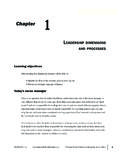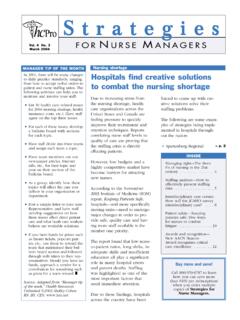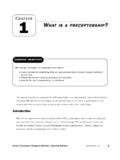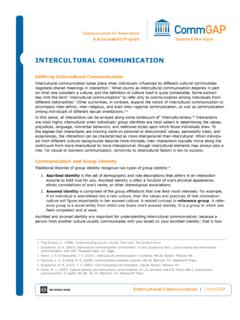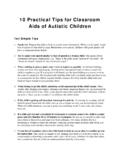Transcription of Introduction: The concept behind shared governance
1 1 SHAREDGOVERNANCE:A practical APPROACH TO RESHAPING PROFESSIONAL NURSING PRACTICE 2006 HCPro, IncIntroduction: The concept behind shared governance Nursing is the protection, promotion, and optimization of health and abilities,prevention of illness and injury, alleviation of suffering through the diagnosis andtreatment of human response, and advocacy in the care of individuals, families,communities, and populations. American Nurses Association (2003)The increasingly critical shortage of professional nurses is a dangerous theme in response to it, more and more institutions are turning to shared governance a conceptChapter 1 Learning objectivesAfter reading this chapter, the participant should be able to do the following: Define the four primary principles of shared governance .
2 Partnership, equity, accountability, and ownership Compare two professional nursing practice models Describe the role of relational partnerships in shared governance 2 Chapter 1: introduction : The concept behind shared governanceSHAREDGOVERNANCE:APRACTICALAPP ROACH TO RESHAPING PROFESSIONAL NURSING PRACTICE 2006 HCPro, into healthcare organizations in the 1970s as an evidence-based method tocurb the shortage s damaging effects ( , negative patient outcomes, high cost of agencystaff, and RN sign-on bonuses). This book takes some of the guesswork out of the variousstructures and processes behind shared governance and provides strategies, case examples,and best practices to make the daily operations of shared governance meaningful and suc-cessful.
3 It also explores the relationship between shared governance and the MagnetRecognition Program by outlining the Magnet program expectations for shared gover-nance is shared governance ?Before it can be solved, a problem must be clearly defined. William FeatherIn its simplest form, shared governance is shared decision-making based on the principlesofpartnership, equity, accountability, and ownership at the point of service. This manage-ment process model empowers all members of the healthcare workforce to have a voice indecision-making, thus encouraging diverse and creative input that will help advance thebusiness and healthcare missions of the organization.
4 In essence, it makes every employeefeel like he or she is part manager with a personal stake in the success of the feeling leads to longevity of employment increased employee satisfaction better safety and healthcare greater patient satisfaction shorter lengths of stayThose who are happy in their jobs take greater ownership of their decisions and are morevested in patient outcomes. Therefore, employees, patients, the organization, and the sur-rounding communities benefit from shared 1: introduction : The concept behind shared governanceSHAREDGOVERNANCE:A practical APPROACH TO RESHAPING PROFESSIONAL NURSING PRACTICE 2006 HCPro, IncFour principles of shared governanceIf shared governance is to allow for cost-effective service delivery and nurse empowerment,decision-making must be shared at point of service which means that the managementstructure must be decentralized.
5 To make that happen, employee partnership, equity,accountability, and ownership must occur at the point of service ( , on the patient careunits). At least 90% of the decisions need to be made there. Indeed, in matters of practice,quality, and competence, the locus of control in the professional practice environment mustshift to practitioners. Only 10% of the unit-level decisions should belong to management(Porter-O Grady and Hinshaw 2005). Partnership links healthcare providers and patients along all points in thesystem; a collaborative relationship among all stakeholders and nursing requiredfor professional empowerment.
6 Partnership is essential to building relationships,involves all staff members in decisions and processes, implies that each memberhas a key role in fulfilling the mission and purpose of the organization, and iscritical to the healthcare system s effectiveness (Porter-O Grady and Hinshaw2005;Batson 2004). Equity the best method for integrating staff roles and relationships into struc-tures and processes to achieve positive patient outcomes. Equity maintains a focuson services, patients, and staff; is the foundation and measure of value; and saysthat no one role is more important than any other.
7 Although equity does notequal equality in terms of scope of practice, knowledge, authority, or responsibili-ty, it does mean that each team member is essential to providing safe and effectivecare (Porter-O Grady and Hinshaw 2005; Batson 2004; Porter-O Grady, Hawkins,and Parker 1997). Accountability a willingness to invest in decision-making and express owner-ship in those decisions. Accountability is the core of shared governance . It is oftenused interchangeably with responsibilityand allows for evaluation of role perform-ance (see Figure for characteristics of accountability and responsibility).
8 Itsupports partnerships and is secured as staff produce positive outcomes (Porter-O Grady and Hinshaw 2005; Batson 2004).4 Chapter 1: introduction : The concept behind shared governanceSHAREDGOVERNANCE:A practical APPROACH TO RESHAPING PROFESSIONAL NURSING PRACTICE 2006 HCPro, Inc. Ownership recognition and acceptance of the importance of everyone s workand ofthe fact that an organization s success is bound to how well individual staffmembers perform their jobs. To enable all team members to participate, ownershipdesignates where work is done and by whom.
9 It requires all staff members to com-mit to contributing something, to own what they contribute, and to participate indevising purposes for the work (Porter-O Grady and Hinshaw 2005; Batson 2004;Koloroutis 2004; Page 2004). shared governance activities may include participato-ry scheduling, joint staffing decisions, and/or shared unit responsibilities ( ,every RN is trained to be in charge of his or her unit or area and shares that rolewith other professional team members, perhaps on a rotating schedule) to achievethe best patient care old centralized management structures for command and control are ineffective fortoday s healthcare market.
10 They frequently inhibit effective change and growth within theorganization and limit future market possibilities in recruitment and retention of qualifiednurses. Summative, hierarchical decision-making creates barriers to employee autonomy andempowerment and can undermine service and quality of care. Today s patients are no longersatisfied with directive care. They, too, want partnership, equity, accountability, and mutualownership in their healthcare decisions and those of their family : Characteristics of accountability and responsibilityAccountability Defined by outcomes Self-described Embedded in roles Dependent on partnerships Shares evaluation Contributions-driven valueResponsibility Defined by functions Delegated Specific tasks/routines dictated Isolative Supervisor evaluation Tasks-driven valueAdapted from T.
